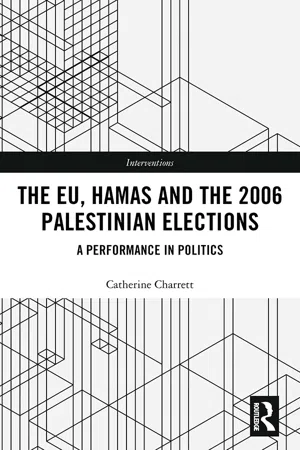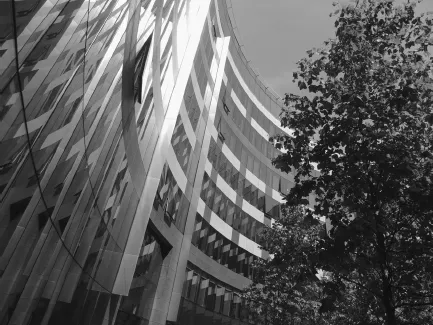![]()
1 Bodies in spaces
Entering, belonging and being in Gaza
and in Brussels
How do the rituals of a space limit what can be said, done, expressed?
By narrating my entering into and being in Gaza and the EU, I present the varied rituals that make up these spaces, and I show how these rituals are performative of and performed by bodies.
Spaces provide an opportunity for bodies to meet, to discuss, to offer ideas. However, the rituals of a space also constrain action and the possibility for critique. Bodies feel compelled to perform the rituals of the spaces they inhabit. The rituals of a space, therefore, maintain a particular order, a particular hierarchy, a certain history. In this chapter, I observe how ritualised orders may close down opportunities for doing things differently. As such, we begin to wonder what is lost in the ordered alignment of bodies and spaces. In this chapter, we will observe the gendered and postcolonial shapes of the spaces of EU–Hamas encounters, and we will interrogate how this constrains action on Palestinian politics. This chapter critiques how Palestinian politics is reproduced ritualistically in European Parliamentarian politics. It observes the various committee meetings, resolutions and human rights discussions that attempt to address the Palestinian question. It asks, how do these rituals reproduce a particular knowledge about Palestine, and importantly how do they omit different initiatives.
The first part of this chapter takes us into Gaza and into the EU through a narration of my entering into these spaces and some of the rituals of entry this entailed. While I do not belong to either of these spaces, I observed the social and cultural rituals that allowed bodies, including my own, to move around and be in these spaces. We will begin to observe how bodies perform spaces as reflections of particular shared knowledges and collective social understandings. The presence of certain objects and architectures presents what kinds of spaces these are and shapes how bodies interact within these spaces. The experiences I encountered in these spaces, such as being subjected to war in Gaza versus talking about war in the EU, offer an idea of the differing experiences that constitute these spaces.
Once we have entered these spaces, we will turn to a narration of what it may mean to belong to a particular space. We observe rituals as proffering a sense of excitement, as bodies are able to properly fulfil the rituals of their space. Here, for example, we interrogate how the EU performs an idea of its own usefulness through the passing of resolutions. We observe how performing rituals involves a reaching out to the familiar, as such we may witness how rituals provide comfort, a sense of belonging. Bodies, however, get stuck through a reaching out to what is always already within reach. Lastly, we therefore turn to an understanding of how rituals may maintain a particular order. What kinds of conversations, experiences or forms of recognition are not bestowed because of the correct alignment of bodies to the social, cultural and political expectations of a given space?
The third part takes a closer look at the kinds of spaces Hamas and the EU inhabit and reproduce. Through ethnographic description of the artefacts and hospitality of these spaces, this section scrutinises the ‘already thereness’ of spaces. It observes how certain spaces work to forget their constitutive and colonial histories. It asks how does this forgetting implicate the kinds of conversations that can be had. While all bodies must perform in order to belong, the gendered and heteronormative ‘coherence’ of a space allows certain bodies and voices to fit more comfortably. Again, this shapes the kinds of actions and initiatives that take shape. In order to upset this coherence and make space for alternative encounters, this section comments on moments and art works that disrupt the alignment of bodies and spaces. It ends with comments from Sinn Fein’s meeting with the Deputy Director of UNRWA in Gaza in December 2012 and the disruptive question, ‘why didn’t you speak up during the most recent attack on Gaza?’ as well as the performance art piece, Nothing to Declare that brings attention to the old Hijaz railway.
Part one: entering spaces and rituals of entry
Moleskine journal entry, 1 October, 2012,
I have just arrived in Gaza. Am I causing problems already? But here I am learning fast to be in this place. I am finding a balance between my own doing and my own following and being in this moment, following the world around me.
* * *
Performances occur within particular spaces. These spaces are bounded by physical or social apparatus. Entering a new space may be obvious as it demanded the crossing of a particular physical border or threshold. Or perhaps the entering of a new space was revealed through the taking up of new actions or the use of a different discourse. Performance artist and theorist Mike Pearson explains that a “performance space may be delineated, cordoned off, set aside: marks, surfaces, structures, both planned and improvised. Activity may be confined to and conditioned by a particular area, volume or architectural feature”.1 Sara Ahmed understands the formation of space through the orientation of the bodies who take up, and move within a particular space; “orientation involves aligning body and space”.2 As such, when a body enters a new space, physical or social, it begins to align itself with the social forms and norms arranged before it. The objects or persons around the body are part of a distinct composition. Ahmed cites Diana Fuss, who states that “the theatre of composition is not an empty space but a place animated by the artefacts, mementos, machines, books, and furniture that frame any intellectual labour”.3 There are objects, people and ways of doing of Hamas in Gaza and the EU in Brussels, and what story does this composition tell?
Tall, cylinder buildings
It is 18 June, 2013. I am entering the European External Action Service (EEAS). It is a tall, cylinder building located in Schuman Place, Brussels. I enter this tall, cylinder building and I am immediately faced with a security desk; to be expected I suppose. Two women occupy the desk in front of me. They ask me who I am there to see and if I have any identification. I exchange my passport for an EEAS visitor’s sticker and a security swipe card, later to be used to enter and exit the building. I am told photographs of the entranceway are not allowed. I sit and wait to be escorted into the building. I sit and wait to enter into this tall, cylinder building, the European External Action service: the “European Union’s diplomatic corps”.4
Figure 1.1 European Union External Action Service building, Schuman Place, Brussels.
Source: photograph by the author, 17 June, 2013.
Figure 1.2 Hamas leader, Mahmoud al-Zahar’s family home, Gaza.
Source: photograph by the author, 5 December, 2012.
As I sit and wait behind the security check in the lobby of this tall, cylinder building, I observe the various security rituals of this entranceway. I cannot help but smile to myself when I recall the various security apparatus that surrounded my visits with Hamas leaders in Gaza.
* * *
It is 5 December, 2012. I am visiting Mahmoud al-Zahar. I am visiting Mahmoud al-Zahar in his family home. I am escorted into his family home along with my translator and friend, Majed Abusalama, by a bearded gentleman who I assume to be a bodyguard, but who doubles as a driver and coffee maker. We enter the simple entranceway and find ourselves in a very large room with beige plush chairs arranged in a square shape. We choose one of the twenty-some chairs arranged in a square shape and sit down. Mahmoud al-Zahar is wearing a jalabiya and is sitting in front of a large poster of his three martyred sons (I recognise the martyred-sons-poster as a constant artefact in all my meetings with Hamas leaders in Gaza). After the interview, al-Zahar takes us outside to show us the various bullet holes in the walls of his house and the various bomb-damaged windows and awnings.
Al-Zahar is one of Hamas’s founding members. He was former Minister of Foreign Affairs and is known for being one of Hamas’s most radical leaders.
I visited Mahmoud al-Zahar in his family home. My entry into his home was not controlled by x-ray machines, visitors’ stickers or passport checks. Indeed the interview was arranged through a phone call –...


